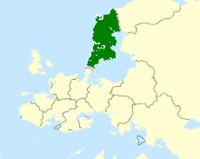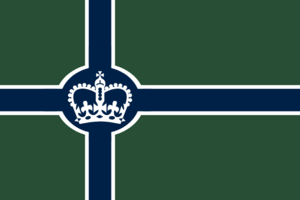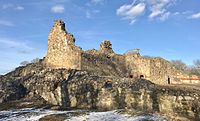Talvistova
This article is incomplete because it is pending further input from participants, or it is a work-in-progress by one author. Please comment on this article's talk page to share your input, comments and questions. Note: To contribute to this article, you may need to seek help from the author(s) of this page. |
Kingdom of Talvistova pyhä talvikuningas | |
|---|---|
|
Flag | |
| Motto: "For Religion, King, and Glory" | |
 | |
| Capital | Ljustad, Osta |
| Largest city | Skalgaard, Osta |
| Official languages | Talvistovan |
| Recognised national languages | German, Libriran |
| Ethnic groups |
|
| Demonym(s) | Talvistovan |
| Government | Hereditary Monarchy |
• King | Oskar I |
• Heir Apparent | N/A |
| Establishment | |
• Independence from Englean Kaiserreich | 31 March 1566 |
| Area | |
• | 878,144 km2 (339,053 sq mi) |
| Population | |
• 2018 estimate | 33,592,671 |
• Density | 15.89/km2 (41.2/sq mi) |
| GDP (nominal) | 2018 estimate |
• Total | 90,322,886,438Ӄ |
• Per capita | 36,841 ӃPC |
| HDI (2018) | .825 very high |
| Currency | Kronig (Ӄ) |
| Time zone | UTC-6 (Kingstown Time) |
| Date format | mm-dd-yyyy |
| Driving side | right |
The Kingdom of Talvistova (Talvistovan: pyhä talvikuningas [Lit. 'Holy Winter Kingdom']; Englean: 'Nordenreich' ), or simply Talvistova, is large nation in Northern Ventismar that borders the Northern Lutentian to the West and North, Strait of Good Faith to the south, Gulf of Paajarvi to the East, and Librira to the Northeast. The capital is the city-province of Ljustad, whereas the largest city is Skalgaard. Other major cities include Manavik, Asbjarnarstaoir, Lonlond, and Kvingandannes.
As of the end of January 2018, the population if Talvistova is 33.6 million, most of which live in the southwestern part of the country and speak Talvistovan, a Nordic language unrelated to nearby German or Libirian Languages. It is a Heretical Monarchy made up of 22 provinces and one semi-autonomous city-province (Ljustad). The Majority of Talvistovans are a part of the Eastern Orthodox Church.
History
Prehistory
If archaeological finds found in caves in the South Kainuu Mountains are in fact the work of Neanderthals, then the first human habitation of what is today Talvistova occurred somewhere between 180,000 and 145,000 BC, while the more northern regions such as the lapland and North Kainuu Mountains are generally believed to have been settled somewhere after 115,000 BC. The artifacts found in said areas carry strong resemblence to those found in North Rukonia and the Englean Kaiserreich, which has lead to a prevailing theory that at one point there was a land bridge that was used as a crossing point across the modern day Strait of Good Faith. Like most of the proto-ventismarin people, the stone age settlers where hunter-gatherers.
The next major innovation that we have record of is pottery recently unearthed outside of Ljustad that is dated to approximately 6,100 Bc, which means that this is probably the time period that agriculture was introduced to Talistova. Although even with the advent of agriculture, it is still largely believed by many archaeologists that it was still very much a hunting and fishing civilization at this point in time.
Around 2,000 BC, the Bronze age brought about year round cultivation as well as animal husbandry, but the cold and rugged climate of the central and northern regions slowed it's advance into the rest of the Country. Around 500 years later, the first major Talvistovan settlement was formed, this being the now abandoned city and world heritage site Taivaan Kehto, and from this city would spread the first notable power a little under 1000 years later, what is now known as the Proto-Talvic Empire.
Proto-Talvic Conquest
For approximately the next 500 to 600 years, the Proto-Talvics where predominately focused on conquering the rest of what would Become Talvistova, and bring the several hundred disconnected tribes under one banner. There is some controversy as to how successful they are, as rune stones discovered in the modern Valley of Plenty have been deciphered to discuss "great victories in the north", whereas those found in the Lapland using a different alphabet mention a great victory against the invaders, although whether they are both propaganda is a hotly debated subject. What is unanimously agreed upon is that by the year 600AD, the campaigns began stalling somewhere around the northern mouth of the Gulf, in what is called "The great stumble" in some carvings from the era believed to be about the topic. It was around this time we also get an idea as to who was in charge around this point, that being the semi-historical King Hrathgar the Ancient, who played a massive part in the development of the two most respected castes in early talvic society, that being adventurers and cartographers, and the raiders and warriors. This era became known as the Talvic Golden Age.
Talvic Golden Age
The Talvic Golden Age is officially recognized as starting around the year of 662, when the first wave of Talvic sailors and map makers set out through the Strait of Good Faith to see and chart what lies beyond it. The most notable of which being a man named
Geography
Talvistova is a peninsula on the southern tip of Courentia, and is the southern most country in Sunalaya. It's dominant feature is the Guds fingre Mountains, which makes up the Country's border with Ourican and also extends into most of the country. Because of this 9 of the 10 most populous cities, Kvingandannes being the exception, are all within 100 miles of the coast.
Climate
Environment
main article: Fauna of Talvistova


